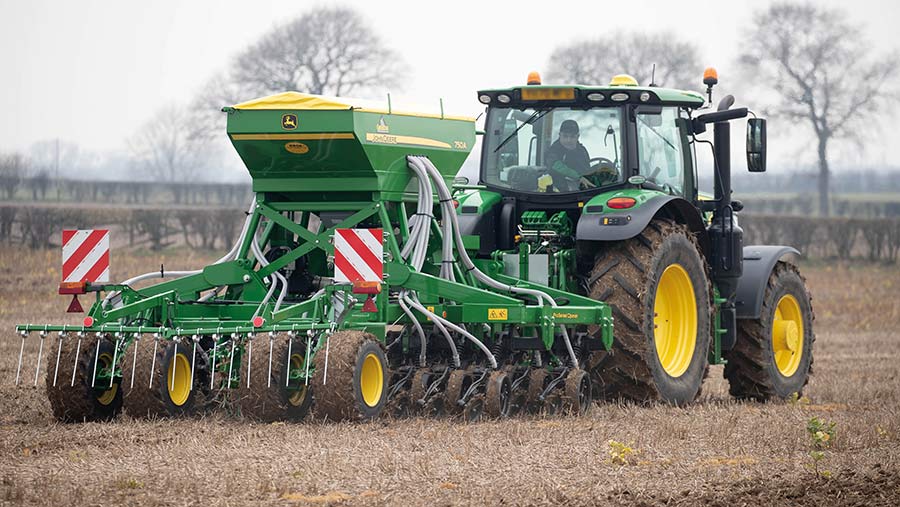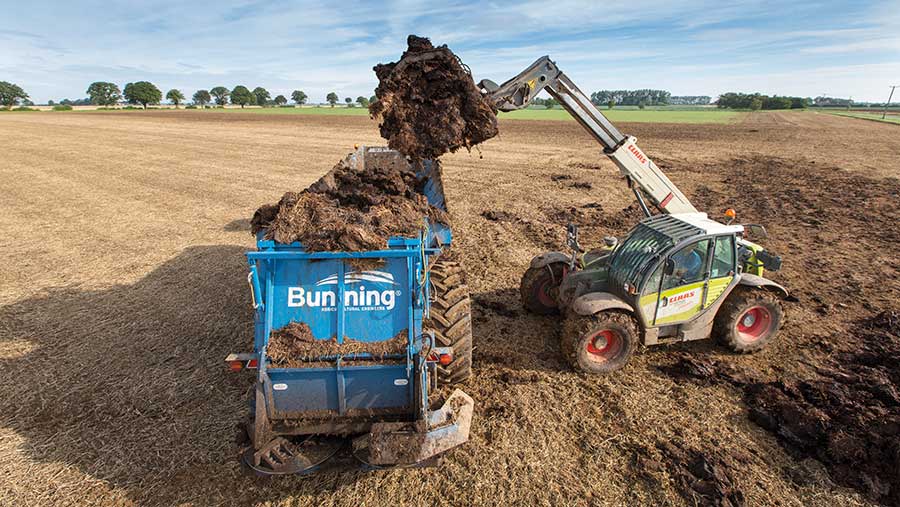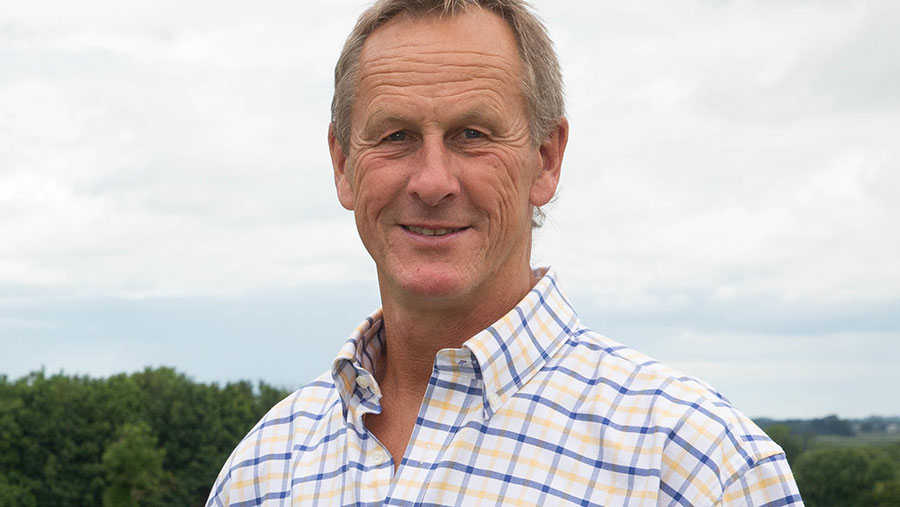Soil carbon: Targets and how to store it in arable fields
 © Tim Scrivener
© Tim Scrivener Farmers have a huge opportunity to help combat climate change by reducing emissions with the adoption of less intensive cultivations, as well as capturing and storing carbon in their fields.
And at the same time, their businesses will benefit from smaller fuel bills as well as having healthier soils by replacing the carbon which has been depleted over the years.
See also: What to consider when increasing soil carbon stocks
The farming sector, led by the NFU, has set itself the target of achieving net zero by 2040. A key part of reaching this target is through the long-term storage of carbon in hedges, trees and soil.
NFU climate change adviser Cerys Jones points out that capturing carbon is only one of the three pillars, the other two being reducing emissions such as cutting diesel use and boosting renewables.
So if farmers are looking to do their bit, what are the realistic goals for carbon sequestration?
Trial data
Rothamsted principal researcher Steve McGrath points out that there is only a finite amount that soils can capture.
Long-term Broadbalk trials show that arable soils receiving manure eventually reach an equilibrium, effectively becoming saturated. The amount will vary by soil type, as the organic matter is bound with mineral particles.
He explains that the crumbs of mineral particles protect the organic matter materials from microbes and their enzymes that degrade them. But it has to be the right type of organic matter – very small compounds.
Another factor to note is the amount of organic matter that needs adding to soils to raise levels.
“You have to add 10 times more than is expected to stay as soil organic matter. About 90% breaks down and is lost, especially the big particles.”
Monitoring also showed that carbon sequestration is not permanent, with carbon levels falling when reverting to low-input cropland. Therefore, the process is reversible and needs to be managed to retain the added carbon.
But it’s not just about tackling climate change, farmers increasingly recognise that having adequate organic matter is essential for good soil health. However, what level should farmers aim for?

© Tim Scrivener
Soil carbon targets
To help farmers benchmark their soils and assess how degraded they are, Rothamsted has been developing a soil carbon index that accounts for different soil types.
The index is based on the relationship between the percentages of clay and organic matter.
Prof McGrath proposes different targets for different land uses.
For arable rotations, farmers should aim to be above 1:13, with soils below this level viewed as degraded. For grass ley/arable rotations, the target is 1:10 and 1:8 for permanent grassland.
Once farmers have identified degraded soils, there are things they can do about raising carbon levels, he says.
He points to 70 years of data from two sites (low clay soil at Woburn and heavier soil at Rothamsted) which saw a trend upwards when leys are in the rotation while purely arable rotations saw a downward trend.
Based on this and other experience, he believes there are three basic practices for raising soil carbon levels.
- Minimise soil disturbance by avoiding mechanical tillage through adoption of conservation tillage and no-till systems.
- Enhance and maintain a protective organic cover on the soil surface using cover crops and crop residues, leys and trees.
- Enhanced crop nutrition through balanced measures that include crop rotations with nitrogen-fixing crops, judicious use of organic and inorganic fertilisers and targeted amendments such as lime where needed to improve productivity.
Case study

Nick Wilson © Hutchinsons
Nick Wilson is using active carbon as a measure of soil health, as he looks to tackle a soil health problem on his 260ha mixed sheep and arable farm in the Vale of York.
He manages three units with varying soils. Most is light being silty, loamy sand over gravel, but he does have some heavy clay land.
The better land has a nine-year rotation with three-year grass leys which have been in this rotation for nearly 100 years.
Clay land in contrast has a five-to-six year rotation based on wheat and two unreliable break crops, oilseed rape and peas.
Farm facts
Hundayfield Farm, Vale of York
- 260ha mixed arable and sheep
- Cropping: winter wheat, winter barley, spring barley, oilseed rape, oats, peas, fodder beet, grass leys and cover crops
- Land let out for potatoes and winter sheep grazing on stubble turnips
- Bed and breakfast cattle
Soil problem
He recalls that eight-to-10 years ago, soil was starting to lose structure, particularly on the heavier land.
After drilling, it was capping after rain with clay particles running together.
He was still getting good establishment, but the root zone was compromised and plants were really struggling to get going. “We realised something was going wrong,” he says.
Also on the better land, it was being overworked with the plough and power harrow. Crop development was starting to become increasingly unreliable in summer.
“We thought we were doing the right thing with a three-year ley, livestock on the grass and applying muck but we were hitting the restart button every year.” But he now acknowledges that it was interrupting biology by disturbing the soil profile.
Strip-till
So in 2013, he moved to strip-tilling on his strong land, as it was too risky to go full direct drilling. The strip-till drill was cultivating down to 10cm. Then from 2019, he strip-tilled the whole farm.
Being one of the Hutchinsons Helix farms, he is benefiting from technology and he has used the firm’s Terramap service to map fields and is getting good data, particularly organic matter and carbon levels.
The data showed that organic matters are about 2-2.5% on light land, and higher where there are rotational grasses.
When looking at carbon on a t/ha basis, the average across the arable fields was about 30t/ha of organic carbon and up to 70t/ha (it was almost double that) for the permanent pasture.
There was also a difference between soil types, with the heavier land storing more carbon? looking better.
Active carbon
But from a soil health perspective, it is active carbon that’s important, as that is the portion which indicates a healthy microbial community (that microbes can consume).
The data revealed that it was the heavier land that had the lowest figures compared to the better land with the more balanced rotation, and he is now tackling this.
He is planning to variably apply manures rather than do blanket applications and target the weaker areas.
At the same time, he plans to continue increasing base levels of active carbon through the arable/ley rotation and making the most of muck for straw deals with neighbouring livestock farmers.
Carbon losses
In addition, he believes the change in cultivation strategy will reduce losses. “We have been increasing carbon losses by over-cultivating the land.”
Cover crops are now being grown which provide both biomass and varied rooting environments which benefit soil biology. Sheep are used to graze them to break down biomass.
“Cover crops bring an extra opportunity in the rotation to add something different to the soil biodome, so not just cereal roots.”
He is already seeing the benefits from his reduced cultivations.
“There has been less ponding [of water] on headlands and they are now performing better. We saw benefits from day one.”
Reducing carbon emissions
Growers have the potential to save 10% on their fuel costs by reducing tillage, says Becky Willson, project officer for the Farm Carbon Toolkit.
This is based on her experience working with farmers calculating their carbon footprints and exploring measures to reduce emissions.
For an average farm using 105 litres/ha of diesel, a 10% reduction will reduce the carbon footprint by 2%/kg of grain sold and saves £2,500 on the fuel bill.”
Another simple change the farmer can make is fertiliser choice, as there is a 20% difference in the carbon footprint of ammonium nitrate in the market, says Nigel Davies, director at Muntons.
Muntons has over the past 12 years reduced the carbon footprint of malt by 32% and part of this reduction was achieved by specifying growers use Yara abated fertiliser.
Compared with other ammonium nitrate products on the market, it has a 20% lower carbon footprint and at no extra cost to farmers, he says.
The experts were speaking at the recent Hutchinsons Carbon Conference, held near Peterborough.
